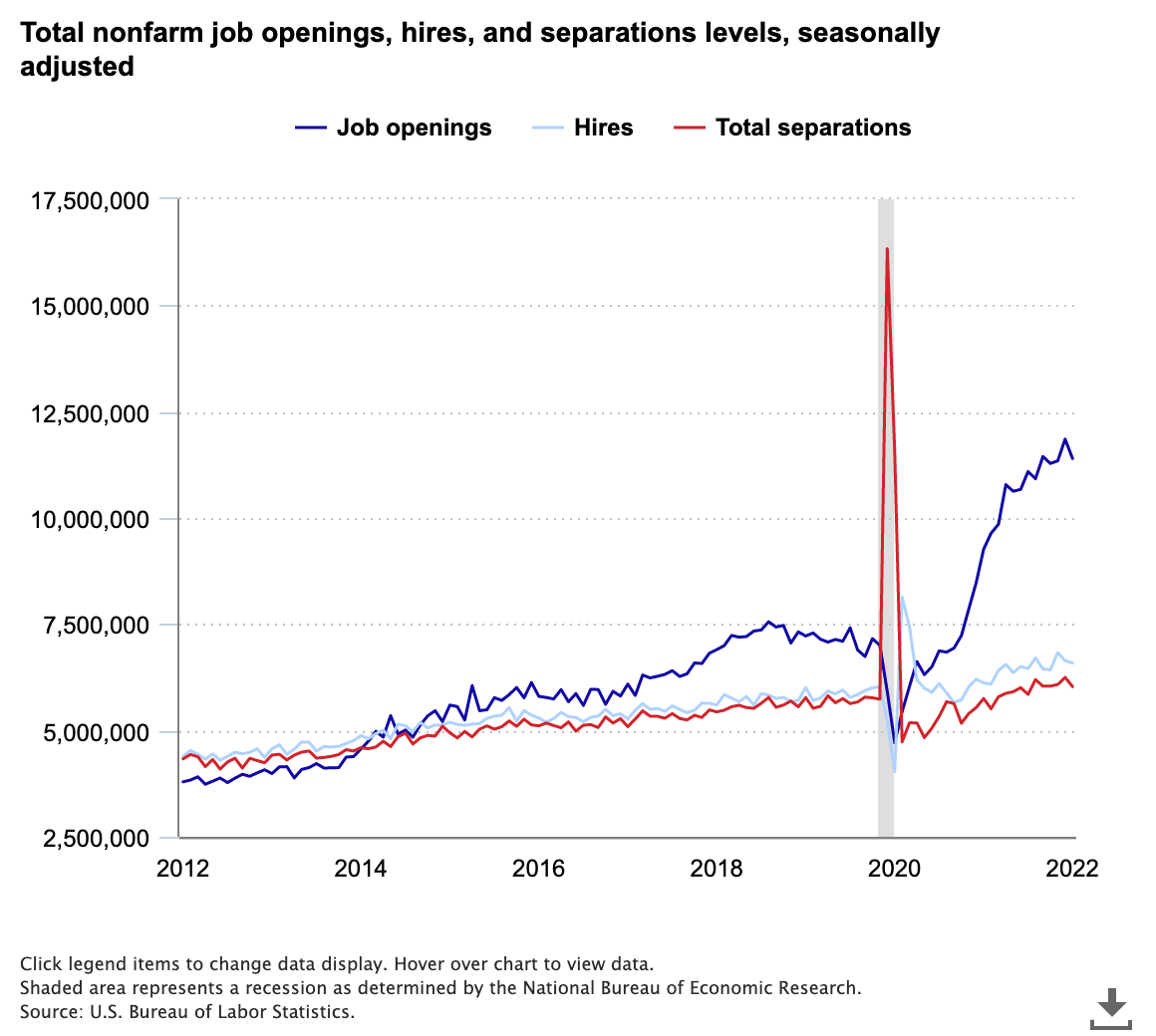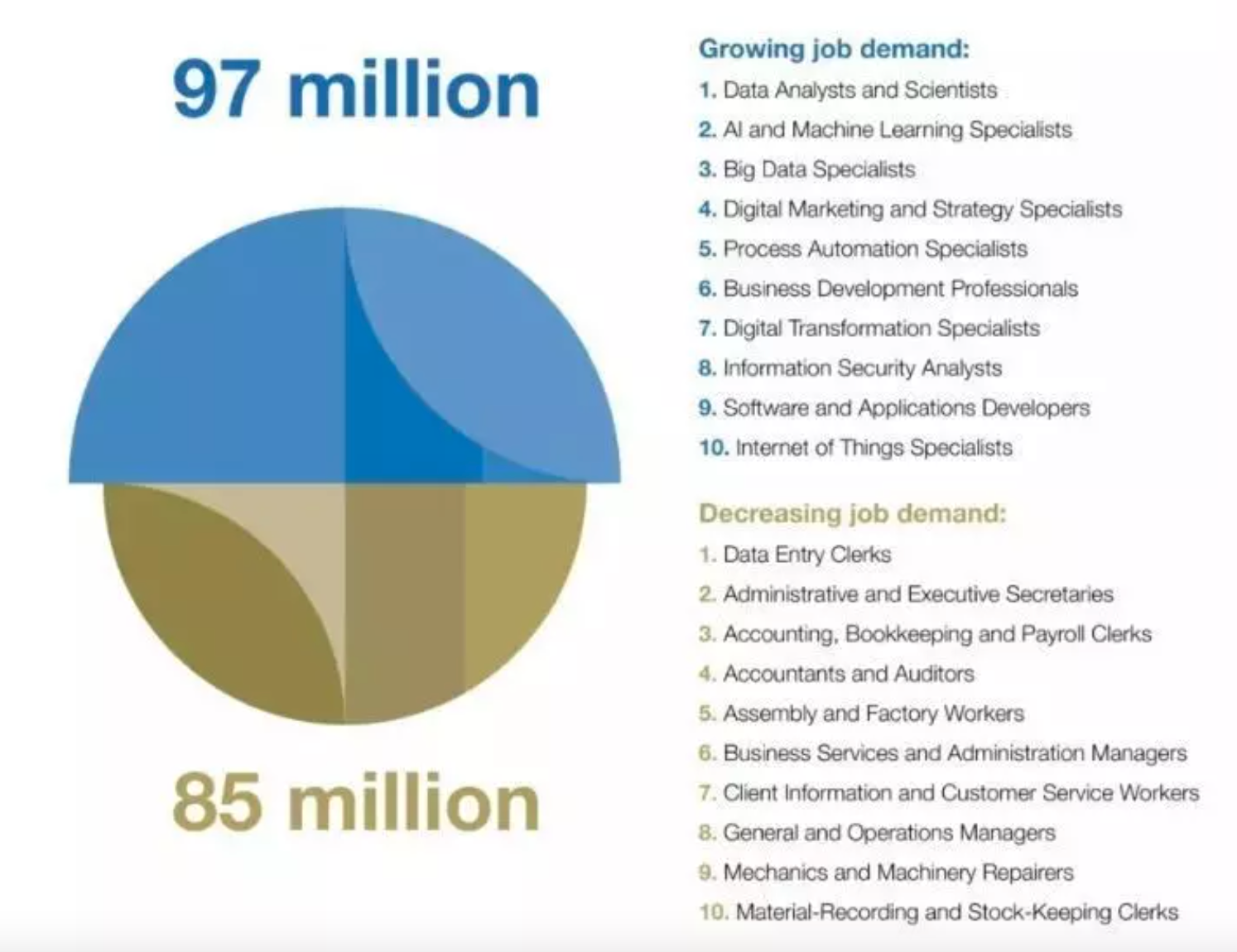Let’s be honest, what the state of talent acquisition and recruiting was in January of 2022 versus what it is now, in June 2022, are two wildly different worlds. In what’s to follow, we’ll look at trends, strategy, and how to best navigate this landmark year for business. It’s not a secret that since day one, the pandemic threw a major curveball at the labor market and business overall which will likely impact brands, both public and private, for many years to come. However we’re here to look specifically at how that has affected talent acquisition and recruiting and even more specifically, this year, 2022.
Job Openings vs Hires
This data from the U.S. Bureau of Labor Statistics shows the job market’s extreme changes since the pandemic, and as of 2022, the peak difference in jobs posted to jobs hired for.

But what is the current climate in certain industries? Tech has been hit the hardest with mass layoffs in 2022. A Crunchbase article states the count, and as of June, at least “17,000 workers in the US tech sector have been laid off in mass job cuts so far.” Thomas Rooke, Talent Acquisition at Cendyn, talks about how the conversations with candidates have changed, “I almost always hear questions regarding job stability, company stability/financial performance, or both. I'm also consistently asked how our organization handled the pandemic and if there were furloughs, layoffs etc.” With Gen Z entering the job market, and on target to make up a huge percentage of employees in the next few years, they are reasonably cautious and asking the questions that need to be considered during such changing times.
The unusually high number of jobs posted vs hired makes this a job seekers market for the foreseeable future. Candidates have their pick when it comes to preferences like remote or hybrid opportunities, company culture, growth and anything else they deem necessary to be happy in their professional lives. A study by the World Economic Forum found that half of Gen Z would prefer to quit their job if it interfered with their work-life balance. Does this explain why the jobs posted versus hires differs so greatly? Are people unwilling to settle nowm where they were before? What is the percent of those jobs that are posted are on-site and how many people looking for new jobs are even willing to work on-site or relocate to be able to work on-site?
Speaking to Torie Jensen, a Recruiting Lead at Qualtrics, she sheds light on the recent changes she’s experienced when speaking with candidates, “The one thing I've found interesting about this time vs. others is that candidates aren't relenting on working preferences. In the past, when we moved into more unsure times candidates would be more willing to relocate, work unusual hours, etc. That's not what I'm seeing this time around. Even though there's definitely a shift in the market and more uncertainty, candidates continue to prioritize the things that are important to them: remote work, flexible hours, PTO, etc. This is something I'm excited about and hope candidates continue to feel empowered to advocate for themselves in areas that support better work-life harmony.”
As for trends, a WEF Future of Jobs report shows the jobs that are growing and declining in demand. Data is king and digital marketing is lending itself to even more data and strategy opportunities. At the same time, while process automation specialists jobs are on the rise, data entry and business administrators are in decreased demand.

Options for Recruiters
What does all of this mean for recruiters? Today, remote work has opened up borders, expanded talent pools and allowed for new skillsets (and software) to emerge. Here lies the new truth in talent acquisition, as well as the way we do business going forward: Work From Home is here to stay.
WFH allows for recruiters to present offers to candidates all over the globe, sure, but what about talent that was really struggling before? “We now have access to a lot more talent, including those who are physically disabled, neurodivergent, or ADHD who prefer working from home, working uninterrupted, and need to be in their own environment,” states Kisha Velazquez, Director of Content Marketing for Joonko. Opening up the board for a host of candidates who can thrive in an environment that is uniquely theirs and can accommodate their personal needs allows for both candidate and company to reach their full potential.
Alexis Madsen, Head of Recruitment at flexEngage, tells us “The biggest recruitment hurdle I've experienced with regard to returning to in-office work, is candidates being concerned with losing the autonomy they experience in WFH. WFH has a plethora of strong points, including enhanced work/life balance, no commute, and increased productivity. We'd be hard-pressed to convince anyone that WFH isn't the preferable option for most of today's professionals.”
Another option that’s been around awhile but is picking up steam with the remote and digital workforce on the rise is the utilization of fractional and freelance talent. Things aren’t great for VC backed tech companies these days. The multitude of companies who have had mass layoffs in 2022 alone is still growing. We saw big brands like Peloton, Better, Robinhood, and Netflix layoff workers as well as a record number of tech startups like Sendoso, OneTrust, Klarna and Bolt. But this doesn’t mean that they don’t still have projects and deadlines to meet. So what happens then? The fractional and freelance workforce is ready and available to help companies achieve their goals while reducing headcount and overhead in a far more economical and time sensitive way than agencies.
Velazquez explains that freelance talent is a good option in that “the timing and specialization in freelancers can help to achieve a singular goal” and notes that while “outsourcing is faster, they need to be managed by someone in-house”.
Rooke points out the fundamental reason that fractional and freelance talent can absolutely be necessary for every company today and going forward, “I do believe that through the great resignation many teams are just asked to do more with the resources they currently have, which is typically less. I feel this mindset helps promote growth within each team/employee but can also induce burnout if not handled appropriately.”
With burnout and a reduction in work-life balance being cited as the main reason for the majority of marketers leaving during the “Great Resignation/Reshuffle,” current employees being asked to do more without additional compensation (not to mention during the highest inflation we’ve seen in decades) is not the solution for long term success for brands today. Allowing them to outsource and utilize creative freelancers and fractional talent allows for brands to complete projects with some of the best in the business, at a fraction of the cost. Jensen states the changes she sees coming “For a while, candidates were less interested in fractional/freelance/contract type work because there was such a surplus in jobs so candidates didn't have to "settle" for these types of roles. The exception to this would be that some companies were more willing to offer job flexibility (flexible hours, remote, etc.) if you were a freelance/contract employee. I anticipate we will see a shift in this as companies plan for a potential recession.”
Going Forward
We are a workforce that is more diverse than ever before, ensuring that brands are a mixture of talents and perspectives allows for a more unified user experience and workplace, also contributing to filling open roles and retaining talent. Velasquez is a strong voice for diversity and inclusion, advising that brands need to “offer more training for recruiters and initial outreach, for example if voices don’t match an expectation from the name you see on a resume, and to watch for microaggressions.”
The world around us is changing and brands are having to utilize solutions and adjust processes to ensure that they are changing along with it. That entails more work from home/anywhere options, ensuring diversity is at the forefront of talent acquisition, work-life balance is reasonable, and when the market is down, those asked to do more with less have options that include outsourcing for project based help, and being flexible when evaluating candidates.
Companies may need to be lean with the economic uncertainty we’re seeing today. Great talent doesn’t disappear either. Utilizing fractional and freelance talent is the perfect answer to running a lean employee headcount and still utilizing expert industry professionals when you need to complete projects. At the same time, great talent has become far more entrepreneurial in the past few years lending for a better network of experienced professionals ready to help.
